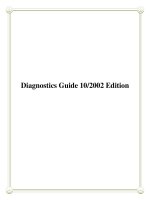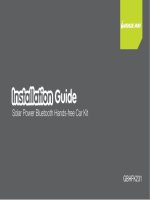Car diagnostics
Bạn đang xem bản rút gọn của tài liệu. Xem và tải ngay bản đầy đủ của tài liệu tại đây (21.36 MB, 144 trang )
Car diagnostics
step by step
OBD diagnostics without the use of devices
OBD I diagnostics
OBD II diagnostics
The most common causes of DTC faults
ECU Flashing and Mapping
EVAP system
Immobilizer
Radio decoding
Control Module or ECM/PCM repair
Radovan MARI
Author
Radovan Marin
General Automobile Engineer
British Institute of Engineering Technology
Aldermaston College
Reading, England
Reviewer
Dr. sc. Darko Biljaković
Editor
and
Graphic design
Radovan Marin
Publisher
d.o.o.
ZAGREB
Kamaufova 2
www.auto-mart.hr
Zagreb, January 2013.
ational University Library in Zagreb
ISB 978-953-95888-4-5
4
R E V I E W
When a failure occurs on our car, the first step that we expect from our
servicer is accurate or nearly accurate diagnosis, because misdiagnosis
has multiple unwanted consequences. To be able to determine what is not
working properly, we have to move in the direction our author went. First
we have to learn how the modern car works, and than we will be able to
figure out how to detect failure. The diagnosis is generally result of experience and a multidisciplinary synthesis of knowledge. Therefore, a new
book of Mr. Radovan Marin “Car diagnostics” connects his previous
books, “Automobile electronics & 4-stroke engines” and “Automobile technology”.
And this time I am pleasantly surprised by the new interesting data and
high quality of expression, as well as with a great number of images. With
this book, author has increased the value of his previous books, which
now form a complete trilogy.
With a risk of repeating myself, I must point out that author has chose
the type of presentation which is a happy compromise of a lot of conflicting requirements such as high skill, legibility, convenience, didacticism
and methodology.
After these three books, it becomes apparent that Mr. Marin is a person
with the rare gift of true professionalism, eager for new knowledge, and
more importantly, with the gift of a good writer and a desire to convey his
knowledge to a wider population. As new technologies are rapidly developing, I am confident that in due time we shall witness new books about
our pets on four wheels. I strongly recommend purchasing of the entire
trilogy, because that would make every part of it to be worth more than it
would have been separately.
Dr. sc. Darko Biljaković
5
6
FOREWORD
After a great acceptance of previous two books "Automobile electronics
& 4-stroke engines" and "Automobile technology", automobile technicians
showed further interest for detailed explanation of vehicles diagnostics
and usage of diagnostics equipment. With this third book, the theory of
automobile mechanics, electrics and electronics on modern cars is generally covered. By mastering content of these three books, technicians will
undoubtedly acquire basic knowledge to deal with most problems on
automobiles. Acquired theoretical knowledge accompanied with everyday’s practical work, which always brings new experiences, will definitely
create a very professional automobile craftsman. It is quite understandable, that acquired knowledge has to be complemented by following new
technologies and modifications of existed.
We should be aware of the fact, that diagnostics programs are sometimes very complex, and have to be considered very seriously. If we would
go in details explaining all functions of particular programs and problems
related to diagnostic trouble codes, a book of several thousands pages has
to be written. This book should provide even more than just fundamentals
of car diagnostics, but certainly not complete knowledge which is gained
by experience and further learning. Therefore, before using a particular
diagnostic program, it is recommendable to study all available literature
about it.
With such introduction about the principles of diagnosing faults, and
assuming that we have mastered the theory from previous two books, we
will surely be able to deal with diagnosed problems and eliminate them.
During the writing of these three books, in addition to several decades of
experience, all worldwide available literature related to this subject matter was used. Beside the literature composed by several authors, knowledge and experiences of individual authors are used too. As it is evident
from the books contents, examples are shown from a range of programs
and automobile data. Just because of so great number of literature and
programs used in these books, the sources, titles and authors are not mentioned by name.
Author
7
Content:
CAR DIAG OSTICS ...........................................................................................
10
Electronic Engine Management ......................................................
10
Diagnosing an engine failure without the use of devices ...............
12
SRS diagnostics without the scanning device .................................
19
ABS diagnostics without the scanning device ................................
22
Resetting service intervals without the use of devices ...................
24
OBD I .................................................................................................
25
Diagnosing failure with diagnostic device .,....................................
25
K and L diagnostics lines ..................................................................
27
KL diagnostics ...................................................................................
29
Installing KL interface and software ..............................................
33
OBD II ...............................................................................................
48
Using the OBD II software and interface .......................................
52
Handheld scanners ...........................................................................
65
OBD II and new vehicles ..................................................................
67
Pending codes P0xxxx * ...................................................................
69
The most common causes of trouble codes ....................................
70
O2 sensor DTC problems .................................................................
70
MAP sensor DTC problems .............................................................
72
TPS sensor DTC problems ...............................................................
73
8
CTS sensor DTC problems ................................................................
75
Misfire DTC problems .......................................................................
78
EGR valve DTC problems .................................................................
80
CKP sensor DTC problems ..............................................................
82
Turbocharger DTC problems ...........................................................
84
Wideband O2 sensor with 5 wires ....................................................
85
Evaporative Emission Control System (EVAP) ..............................
87
ECU Flashing i Mapping ..................................................................
89
Immobilizer ........................................................................................
95
Additional protection from car theft ...............................................
101
Radio decoding ...................................................................................
108
Car parking sensor system ................................................................
112
Control Module or ECM/PCM repair .............................................
116
Transistor testing ...............................................................................
120
Resistor testing ...................................................................................
124
Capacitor testing ................................................................................
126
Cruise control .....................................................................................
129
Start/Stop system ...............................................................................
135
Regenerative braking system ............................................................
138
HHO ....................................................................................................
139
9
CAR DIAG OSTICS
Electronic Engine Management
In the previous two books, Automobile electronics & 4-stroke engines and Automobile technology, it
is pretty thoroughly explained the
principle of new types of petrol
and diesel engines, as well as electronic engine management and
other car components. Bearing in
mind that users of these two previous books have studied them, and
they are now clear with a function
of the electronic management and
its associated components, i.e. sensors and actuators, in this book we
will proceed with process of diagnosing faults in the electronic system using diagnostic devices, and
without them on the types of vehicles where it is predicted by manufacturers.
The concept of basic diagnostics
was explained in the first book:
OBD diagnostics, protocols and
use of diagnostic tools. With this
basic knowledge many people was
enabled to use diagnostics tools
and understand the purpose and
possibilities of their use in combination with the acquired knowledge about the function and manner of testing sensors and actuators in the vehicles. All those who
have used their newly acquired
knowledge in practical application
are aware of its complexity and
almost daily updating demand. So,
let’s go ahead, or continue in following order.
10
In the beginning, let’s recapitulate our knowledge related to the
electronic engine management and
transmission under the common
name Powertrain.
Engine computer, or we can say
command center, in which all the
information are flowing in from a
wide range of sensors and commands are sent out to a range of
actuators is known as ECU, or on
the newer cars PCM Powertrain
Control Module.
Lambda probe or O2 sensor provides information about saturation
of carbon monoxide in air-fuel
mixture after combustion. On the
base on received information the
computer adjusts the mixture, constantly keeping proper air-fuel ratio and thereby minimizing fuel
consumption and emission of
harmful gases. In newer cars an
additional lambda probe is fitted
and located behind the catalyser or
downstream. This probe measures
the final value of emissions and
may also indicate a malfunction of
the catalyst. Lambda probe is
somehow popular among mechanics to cause a series of failures, and
often interpreted as the cause of
problems related to improper engine operation. Lambda probe
malfunction will cause increased
fuel consumption, performance
loss and increased emissions, but
the engine will still operate satisfactorily. amely, in the case of O2
sensor failure, computer will con-
trol injectors by spare installed
program which will regulate the
amount of fuel injected relying on
following parameters: engine
speed, intake air quantity, etc. In
other words, the dosage of fuel
based on these parameters will be
quite correct, but not ideal as in
the case of the properly functioning probe.
Coolant Temperature Sensor
CTS is very important for the engine cold starting and driving before the engine reaches operating
temperature. Having received information about the engine coolant
low temperature, computer will
inject greater amount of fuel and
proportionally reduce it as the
temperature
increases.
After
reaching operating temperature,
the computer will rely on the parameters received from lambda
probe.
Parameters of the TPS, throttle
position sensor, on the engine inlet
manifold, computer will use, along
with other sensors parameters, for
proper ignition timing and fuel
dispensing. One of the most important data of this sensor is sudden
acceleration, when computer have
to inject a greater amount of fuel
to avoid the engine sudden stoppage (dead spot) caused by entry
of large amounts of air into the engine.
MAF, mass air flow sensor, provides the information about the
amount of intake air at certain engine speed which computer will
use in the calculation of fuel dispensing.
Depending of the type of engine,
MAP manifold air pressure sensor
and IAT, intake air temperature
sensor, can be installed in conjunction with the MAF sensor or without it. The parameters of these two
sensors will further assist in the
proper dosage of fuel, depending
of intake air temperature and engine load.
Engine crankshaft position sensor CKP at any point shows the
position of the crankshaft and pistons. Data from this sensor will
allow the engine computer determining the exact moment of fuel
injection and spark on the spark
plugs. This is the only sensor due
to which failure engine will not
run.
Besides the CKP sensor, on
higher performance engines one or
two camshafts CMP sensors are
fitted too. These sensors send information about the exact position
of camshafts and thus the exact
time of engine valves opening and
closing which facilitates accurate
calculation of ignition timing and
fuel injection.
Knock sensor records the vibrations, or knocking, caused by the
detonations inside the engine cylinders. The received signal computer
will use to adjust the ignition timing and prevent premature ignition of the mixture due to inadequate fuel octane value or higher
engine loads.
These sensors are an integral
part of the today’s car engine
management. Additionally, depending on the type of vehicle, we
11
will find a number of other sensors
on the engine which further improve engine function and performances. As sensors are essential
for proper engine functioning, so
they exist in other vehicle devices
too: transmission, ABS, air conditioning, SRS ... controlled by separate modules or computers.
On today's cars, it would be
impossible to achieve high performance and simultaneously satisfy global regulations related to
pollution emissions, without the
use of electronics. Very rigorous
emission regulations forced the car
manufacturers to introduce a very
complex electronic engine management which increased production
costs. On the other hand, new
technologies have multiplied and
improved engine performance,
thus saving on the production of
robust high capacity engines that
have been, until now, incorporated
into high-performance cars.
Electronic vehicle’s management, at first glance, seems quite
daunting. However, if the material
from the previous two books has
been mastered, with the help of
instructions in the following chapters and the various, now available, diagnostic tools at affordable
prices, and even without them in
some cases, we will be able to diagnose the most failures in the electronic car systems. Why the most?
It is not uncommon for the DTC to
occur as a consequence of other
DTC, in which case it takes a lot of
knowledge and experience that is
gained over time to solve the prob12
lem. In any case, using the current
knowledge and some effort, we will
be able to diagnose even such failure by eliminating consequential
DTC on the basis of checking the
validity of some electronic elements, and logical conclusions derived by linking their functions
and interactions.
Diagnosing an engine failure
without the use of devices
As already mentioned in previous publications, OBD or On
Board Diagnostic means that the
engine computer diagnosis DTC of
electronic systems and stores them
in the form of codes in its memory.
Some carmakers have predicted
the possibility of accessing the
codes without diagnostic devices. It
is mostly the case on Japanese
cars, not late models, and can be
also found in most European car
models.
As on the newer cars generation
almost nothing is simple, even such
process of diagnosis will not be
possible without the assistance of
provided auto-data. As each type
of car has a specific way to access
data from the engine computer, we
need to find the vehicle manufacturer's instructions. Such information can be found in various commercial vehicle data programs,
which are conducted under various names. One of the most popular is Autodata. In the lack of such
commercial data, a little wiser and
more persistent may seek instructions on the Internet.
For the first example to diagnose failure on the engine elec-
tronic management we will take
the car model Honda Civic 1.4
made 2000. Here we shall use the
instructions from the one of many
databases available Autodata. In
browser we choose: the year of
manufacture, brand and model of
vehicle. In the right column we see
the capacity of engine installed in
this model of this car, and at the
bottom of the page we can select
the type of engine selected by serial number and power. In the
program header, we will select the
option to diagnose trouble code or
DTC. By clicking on the selected
13
option, two additional options are
offered: engine management and
air bags. To begin, we choose the
first option. On the newly opened
window we can immediately notice
the ability to diagnose without the
assistance of the diagnostic device.
In fact, otherwise in the right column only one sentence would be
written which indicates that access
is only possible with diagnostic device. In such happy circumstances
where we can access the data from
the computers without diagnostic
equipment, fault diagnosis can be
approach in the following order: in
the left column, we are offered 5
different connectors for plugging
diagnostic devices (in most cases it
is just one) and sketch of its position in cab car. Concluding that in
our car we have connector with
only two terminals, we shall select
Type 1 solution. In the case of connector with multiple terminals, we
14
shall click on different type of connector opening its sketch. Choosing connector identical to the vehicle’s we are prompt to the option
of general information. In the
right column of the new page we
get information to read error
codes by counting the flashes of
the MIL light, actually the same
light which warns us about the
faults in electronic management.
Further information from this
site in our case is not so important,
and therefore we shall go directly
to the option on the left, or: Accessing data. On this page, in the
column on the left we see the connection or connector where terminals 1 and 2 are bridged with a
piece of wire. Let’s go to the right
column of the page and follow the
exact procedure describing accessing data. Instructions go in this
order: bridge terminals 1 and 2 on
two terminals connector, do not
bridge the terminals on the three
and five terminals connectors,
switch the ignition O , count the
flashings of MIL light on the instrument panel, write down the
codes defined by flashings and
compare them with the code’s ta-
ble. If the MIL light illuminates
constantly, there are no faults
stored in the engine computer.
Further on, follow instructions
how to read trouble codes by
counting flashings and following
pauses between them. Error codes
15
from 1-9 are shown in the following order: the number of short
flashings followed by short breaks
indicates the error code. In this
case, the code number 3 is visible
on the sketch in the lower left corner of the column. A longer pause
between flashings separates the
codes, or we read the new code.
Error codes with values greater
than 9 are read as follows: a longer
duration of flashings indicates the
value 10, each following brief flash
followed by short break has a
value of 1, long pause marks the
end of the code and next code
comes up if exists. On the previous
16
sketch in the lower left corner we
see an example of the existing code
under the number 12. If read code
is not clearly listed in the code’s
list, we can suspect a malfunction
of the engine computer.
Reading out error codes, diagnostics procedure is completed and
we can proceed with deleting codes
after we have written them down
on a piece of paper. ow, we can
return to the left
column of the
page and select
Erasing or deleting. Clicking this
option a new page
opens where we
find the instructions for DTC removal on the right
side of the page:
turn the ignition OFF, remove the
wire that we bridge the terminals,
remove the fuse of 7.5 A sketched
on the left, and put it back after 10
to 15 seconds. There are two
sketches of the fuse, depending of
the engine type listed on the right
side. The DTC can
be also erased by
removing one of
the battery terminals for 10 to 15
seconds.
Finally, like
all other jobs
when they are
done, they look
simple and easy.
However, finishdiagnostics
ing
and erasing DTC we have not
solved the problem nor do we
know where the problem lies.
Therefore let’s move further on to
decipher recorded codes. On the
left side of the shown window,
choose the option Trouble code
identification. The newly opened
site contains a list of DTC definitions.
Suppose that we have read the
above mentioned diagnostic trou-
ble codes 3 and 12. In DTC definition list under number 3 we see the
problem related to the MAP sensor, but not the advice to replace
it. So, now we are back on knowledge. This definition gave us only
the orientation to the sector of possible problem. To be certain that
we are properly eliminating exist-
ing problem without unnecessary expenditure, it
is necessary to know what
the MAP sensor is and
how it works. The DTC
description points to the
possibility of problems
with the wirings, connector and sensor itself or
even the engine computer.
So if we have learned
from previous books how the sensors work, we will be able to test
the sensor itself as well as the
power supply. After we carried out
all possible checking, we can conclude with great certainty where
the problem lies. Similar case is
also with a code 12 which indicates
a problem with the EGR valve.
And here we get only the orientation about the problem, because
the problem may lie in the wiring,
vacuum hoses, EGR solenoid valve, the valve position sensor, EGR valve or
finally in engine computer. Therefore, we need
to know how the EGR
valve works, to be able to
determine with certainty
where the problem lies.
This diagnostic procedure
clearly shows how diagnosis of vehicle’s electronics management, with the device or without it,
is not a magic where we can point
out the problem with the finger
and say: this is the part which has
to be replaced. In other words,
only after the diagnostics is performed, the right knowledge comes
to the fore. Certainly there are
17
cases where the problem is solved
by changing certain elements, but
I would classify such cases into the
lottery game, rather than professionally performed work. But if we
still want to perform our job professionally before we bring our self
and customer in an unenviable position regarding possibility of unnecessary and non small investment in repair which is caused by
changing parts in the order of
elimination until the error is removed, we will use these databases
which provide information of each
element value during the testing.
For example, in the trouble code
line number 3 we have the possibility of entering the MAP sensor
page by clicking on the highlighted
text and find the description of error. By selecting this option, we
will find the sensor testing description and all sensor values which we
have to obtain during the test. Just
18
like with diagnosis, and here we
find the instructions and drawings
for sensors testing. Sentences are
short and relatively easily understandable. The sequence is very
similar to the preceding. Check the
power supply: turn ignition off,
unplug the connector from the
MAP sensor, turn ignition on,
check voltage between terminal 1
and the earth, check the voltage
between terminals 1 and 2. In both
cases, the voltage should be about
5 volts. Check the MAP sensor signal: turn ignition off, do not disconnect connector and approach
connector terminals with voltmeter from the outer side, switch ignition on, check the voltage between terminals 1 and 2 whose
value should be about 3 volts. So
verifying power from the engine
computer and the sensor signal
voltage, we can easily guess
whether the problem is associated
with the sensor, wiring, connector
or the engine computer. DTC 12 in
this database does not have a test
description as it was the case for
MAP sensor, but if we go back to
the EGR valve chapter in our book
Automobile electronics & 4-stroke
engines, we will be able to make
very quality valve, sensor, and wiring tests.
Described diagnosing procedure
without the use of diagnostic devices is identical in all types of vehicles. Of course, every type of car
has a different terminal bridging.
That's why we need instructions
for a particular model that has
data access from the computers in
the described manner. How to
know which vehicles can be diagnose this way? For this kind of information it is necessary to have
one of sketched data, workshop
manual for particular vehicle or
with a little effort information can
be found over the Internat. This
last method is a bit complicated,
but perseverance is often rewarded. When using the Internet,
it is always recommended to consider the usage of closest key
words to find what we are seeking.
Let’s say that we are trying to find
a workshop manual to diagnose
Honda car without the diagnostic
device. Appropriate key words
would be: How to access DTC on
Honda by MIL or how to access
error codes using MIL lamp on
Honda vehicles. These and similar
concepts, will surely lead us to a
title in which we can find the instructions we need. Surely, such
process is sometimes time consuming and laborious, but with a lucky
hand, it may happen that at first
attempt we get the right information. Frequent use of Internet to
obtain the required data, will leave
a positive mark in terms of memorizing professional terminology
which will spontaneously very
quickly get into the everyday’s use
of professional expression.
As we saw at the beginning of
this chapter, when choosing a diagnostic failure, in addition to the
engine management we are offered
the option of diagnosing failure of
ABS and SRS Supplemental Restraint System, whose translation
could be: an extra stop system
linked to existing, referring to already installed seat belts. Well,
let’s now perform diagnostics on
air bag system in the same vehicle.
SRS diagnostics
scanning device
without
the
Getting back to the menu, we
shall now select the option Airbags.
After new page is opened, a new
menu is offered with general data
on the top. On the right hand side
we can notice instruction to perform diagnosis without the scanner and reading DTC again by
counting MIL flashings, in this
case SRS MIL light, while in the
lower left corner we see the position of the connector, or DLC, for
diagnostic scanner. Moving to the
next page by clicking on Accessing
Trouble Codes, we find the instructions to access information from
19
module or SRS computer, and on
the left side we can see the drawing
how to bridge the terminals. Here
is the procedure of diagnosis on
the right side of the page: turn ignition OFF at least for ten seconds,
find the connector (sketched) with
two terminals, bridge the terminals, switch ignition O , the SRS
light flashes six seconds, if there is
an error MIL starts flashing, write
down the number of flashings and
compare them with the codes on
the list. Each error, or DTC, consists of two groups. Long flashings
indicate the tens and short ones
single numbers. Short pause sepa20
rates
flashings,
long pauses are
separating codes.
As an example,
code 12 is shown
in the sketch in
the lower left corner. Finally, turn
ignition OFF for
ten seconds and
remove the bridge
wire
(jumper).
Module or SRS
computer can also be tested by diagnostic device connected to DLC.
ow we can proceed with erasing stored codes by clicking on the
option Erasing Trouble Codes and
following the instructions: turn
ignition OFF, find two pin SRS
connector to delete the stored data
(sketched in the left corner of the
page), bridge the terminals, switch
ignition O , the SRS light flashes
six seconds, remove bridge wire
within four seconds after MIL is
turned OFF, the
MIL lights up
again, bridge the
connector terminals again within
four seconds, light
goes out, remove
the jumper within
four seconds after
the MIL turns
OFF, light flashes
twice and errors are eliminated
from the SRS module, turn ignition OFF.
Finishing diagnostics procedure
we can proceed with a definition of
trouble codes by switching to
Trouble Code Identification page.
On the right side of the page we
connector, the airbag unit or the
SRS module. As
we see in the description of the
code, there is only
an orientation to
the problem but
does not give a
much of advice.
But, at least we
know in which
bush the rabbit
lies. Thus, we have to check the
contacts and the wiring of the
driver airbag unit. If that does not
encounter a noticeable problem,
we can move on to
test the air bag
unit.
Knowing
that the airbag is
activated by electric igniter, we can
assume that there
is some resistance
on air bag unit
terminals,
but
look for read
DTC number 12 and
interpret the
definition
which says:
great resistance on the
driver's airbag.
The
problem
may be related to the
wiring
or
21
what is its value? The resistance
value has to be found in the manufacturing literature, workshop
manual, or again over the Internet.
When we find the value of resistance, we can verify it with assistance of Ohm meter. If the measured resistance value significantly
differs from the specified, the
problem lies in
the air bag unit.
In both diagnostic cases we
jumped to the
DTCs erasing
procedure before we solved
the
existing
problems. It is
quite
obvious
that failure has
to be eliminated
before deleting
DTC from memory, otherwise it
will appear again. But sometimes
there are trouble codes memorized
in module’s memory but we can
not see that there is anything
wrong with engine or other systems electronic management. In
such cases, we can erase DTCs and
see if the same will occur again. In
fact, sometimes the DTC is saved
due to some other circumstances
while driving, and how it appeared
so it disappeared. However, the
computer registers a problem, regardless of its duration and never
deletes it by it self. Therefore, if we
doubt the existence of a fault, regardless of the stored errors, we
can erase DTCs, and after a short
drive repeat the diagnosis.
22
ABS diagnostics without the scanning device
The problem with the ABS MIL
which illuminates because of malfunction of the ABS system can
also be solved in a similar manner
as the previous two on this vehicle.
If we select option ABS Component
Testing, the program will show us
a menu similar to previous with
the instructions of the availability
to access the codes without the use
of diagnostic devices. In the option
Accessing Trouble Codes we follow
the instructions: turn ignition
OFF,
bridge
the
terminals
(sketched), switch ignition O ,
ABS light starts flashing, longer
flashings indicate tens and short
single numbers, short pause separates flashings and long ones error
codes, longer flash followed by two
short ones indicate DTC 12
(sketched), write down read codes,
turn ignition OFF and remove
jumper.
Deleting codes: turn ignition
OFF, bridge connector terminals 1
and 2, press the brake pedal and
hold it pressed, turn ignition O ,
hold the brake pedal pressed until
ABS light goes out and than release it, wait until MIL turns on
again, press the brake pedal and
hold it down, wait until light goes
out and release the brake pedal,
wait five seconds, the MIL flashes
twice and errors are deleted, remove jumper.
If we move to the next option
Trouble Code Identification and
look up the definition of code 12
which we read, it is immediately
noticeable that this error is easily
solvable. The code definition indicates a short circuit in ABS sensor
of the front right wheel. With such
clear definition, most will immedi-
ately proceed with sensors
replacement, and the
problem is solved. But
those little pedantic, will
make a sensor test before
replacement. amely, as
already mentioned, we
should never fully rely on
the codes definitions to
make final diagnosis,
which may be wrong and
expose the customer to unnecessary costs as well as bring us in an
uncomfortable situation. In this
case, rather than having problem
with the sensor, there may be a
problem in wiring or sensor’s connector which is short connected for
a number of possible reasons.
That’s why precautionary checks
have to be always made, especially
if we have access to data as we
have in this database. On the attached sketches we see
the option of checking
the ABS system elements, or in this case the
sensor. The sensor resistance whose value on this
vehicle is between 750
and 1050 ohms can be
measured on the module
connector terminals,
connecting the instrument to the marked terminals. However, such checks do
not exclude a potential problem of
short-circuit on sensor connector
or its wiring. Therefore it is advisable to measure the resistance at
the terminals of the sensor located
on the wheel hub. Only if we found
no resistance on the sensor termi23
nals, we can conclude that there is
a short circuit inside the sensor
and replace it.
Resetting service intervals without
the use of devices
Beside the possibility to perform
diagnostic operations on hundreds
car models without the use of diagnostic devices, by using these databases we can also reset service intervals on most of them. Here is
shown example on BMW 3 Series
(E36) 1.6 316i year 2000. After selecting a vehicle’s brand and
model we choose the option Service
Indicator or a similar topic on dif24
ferent types of
cars. On the left
side of the page,
diagnostic connector drawing is
visible
with
marked terminals.
Above the drawing, menu offers
options to reset
the oil service
warning light, inspection
service
warning light or all service warning lights in the package. So, let’s
select this reset in package by
clicking the last
option and follow
the instructions:
switch
ignition
O , connect a test
lamp between terminal 7 and the
ground (ground is
anywhere on the
metal part of the
body or engine),
after 12 seconds
five green LEDs
will illuminate on instrument
panel, turn ignition OFF, wait
twenty seconds, switch ignition
O , reconnect the test lamp to terminal 7 and ground, after 12 seconds all five green LEDs on the
instrument panel will illuminate
again, turn ignition off and reset is
complete.
Ability to access data stored in
the modules or computers memory
as described enables us to engage
in repair and to deal with problems on hundreds of car models
without the a number of expensive
diagnostic equipment. These options should not be ignored even
when it comes to cars for which we
suspect not to be able to handle
tests without a diagnostic device,
but there are always surprises
even when we least expect them.
Therefore, always check if there is
a possibility to do diagnostic or
reset service intervals without the
use of scanning devices.
OBD I
Diagnosing failure with diagnostic device
In this chapter, let's start with
instructions and examples using
OBD I diagnostic devices and related software. As it has been already mentioned in the book Automobile electronics & 4-stroke engine, OBD diagnostic system is divided on OBD I and OBD II. Repeating already read text, in most
cases it is very useful. Therefore,
let's say one more time that OBD
On Board
Diagnostic
means that
engine and
other system comp u t e r s
have
the
ability to
diagnose
faults
of
electronic
management of the
entire car by them self. Of course,
every computer or module does it
for certain system. It also means
that the engine, ABS, SRS, AC and
other systems have a separate
module which is often called the
Electronic Control Module ECM
and control particular system on
vehicle. Although the modules or
computers are separated and responsible for managing the system
and diagnosing faults in their system, they can be connected if they
interact. For instance, the ECU
Engine control unit in newer cars
is associated with the ABS module.
The interaction of these two modules is necessary on vehicles with
embedded ESC Electronic Stability
Control system. ESC as a separate
system has installed own software
in its ECM. However, ESC can not
control the vehicle stability if it
does not use the ABS system.
Therefore, ESC module is associated with ABS module. However,
vehicle’s stability is not controlled
only by ABS, but if necessary, engine power is reduced in critical
25









